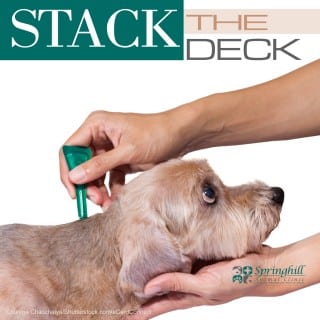Even if you don’t reside in a flood prone area, flash floods can strike almost anywhere. As quickly as water can rise, being proactive and starting a neighborhood network for your pets and others is a smart move and kind gesture. If anyone in the network is not at home when a flood warning is issued, but pets are, a network could prove invaluable in getting beloved pets to safety. When putting together the information for the network, include pet names, ages, favorite hiding spots, as animals will hide in times of danger, vaccination history and where pets should be taken during an evacuation so everyone will know where to check to find their pets safe and sound.
Before the waters begin to rise, make sure your pet is properly identified with a collar, up-to-date identification tags and a microchip. Remember to update your contact information for the microchip registry at least once each year. Collars and tags can come off a pet during a disaster — or anytime — but microchips are routinely scanned by animal shelters and rescue groups, giving them a way to contact you in the event of a separation.
Also, make sure all vaccinations are kept as up-to-date as possible so you don’t run the risk of your pet facing additional safety and health hazards. In the event of a separation, your pet could be exposed to any number of diseases and conditions preventable by current vaccinations. Having current medical records and photos of your pet on hand is also a good idea as this information can be shared with shelters and other agencies who may find your pet.
Put together a pet-focused emergency kit for use both during and after an evacuation. This kit should include:
– A pet-appropriate personal floatation device (PFD) in case you need to navigate high waters
– Collars, leashes and carriers
– A minimum of two weeks’ worth of pet food and bottled water. As with human food, pet food does expire, so make sure to check expiration dates and rotate the supply during the year. Also have extra bowls and can openers for use.
– Blankets, towels, treats and toys. In high anxiety and stress situations, such as the days following a flood, a few reminders of normalcy can benefit your pet and you.
– First aid kit. The kit should have medications, anti-bacterial ointments, bandages, adhesive tape, sterile wound wash and other medical supplies needed for helping an injured pet.
Prior to evacuating, identify pet-friendly locations. Check with boarding facilities, pet-friendly hotels or relatives or family friends outside the impacted area about taking care of your furry friend for a period of time.
However, if you are able to keep your pet with you, after you have evacuated to higher ground, your pet should stay on a leash or in a carrier. Snakes and other animals may have also sought out that higher ground and could pose a safety risk to a loose pet. Don’t plan to use a car to secure your pet during or after a flood and never leave your pet unattended in a car while you’re dealing with a flood or its aftermath. Cars can easily be swept away in flood waters or flooded out if left stationary, along with the concern that temperatures inside the vehicle can reach unsafe temperatures quickly.
While clean water can be hard to find after a flood, avoid allowing your pet to drink flood water. Sewage and chemicals, along with debris, are often found in flood waters, posing a serious health threat to your pet. Also, parasites such as mosquitoes and giardia can flourish in the abundance of flood waters, leading to illness for your pet.
If you have large animals, such as cattle and horses, keep a current list of all animals and include their location, vaccination records, ownership and form of permanent identification. The permanent identification could be an ear tag or tattoo. Just as with small animals, prepare an evacuation kit. Items to include are:
– Handling equipment such as halters and nose leads
– Water, feed and medications for three to five days
– Buckets for feeding and tools needed for manure cleanup
Make evacuation arrangements for your large animals, such as determining several routes to higher elevation or alternate facilities. If you will be unable to transport them, have arrangements in place with experienced handlers and drivers. However, if you must leave large animals behind, keep gates and buildings open so the animals can escape the rising water.
Floods are a year round threat. While they have a reputation for the extremes, having a plan in place and going through that plan prior to an evacuation order will help you and your pet smoothly sail through this stressful situation.



